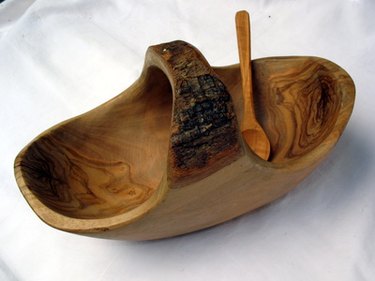Things You'll Need
Dish-washing soap
Sponge
Pumice stone
Lemon
Wood putty
120-grit sandpaper
Mineral oil
Soft rag

A good, quality wooden bowl can be passed down and used in the kitchen for generations. Wooden bowls may be used for salad prep and kneading bread. They also add rustic charm to a table when used as a serving bowl. Improper care and cleaning can cause the wood to dry out. When the oil content of the wood gets too dry, the bowl may crack. Large splits or cracks may be impossible to patch, but small nicks, scratches, stains and residue build-up can be repaired.
Step 1
Fill a sink with warm water and one tablespoon of dish-washing soap. Dip the bowl into the sink and scrub it with a sponge to remove food particles. Dry the bowl with a clean towel.
Video of the Day
Step 2
Cut a lemon in half and squirt the lemon juice inside the bowl. Scrub the bowl with a pumice stone to remove all built-up oils and other residue. Rinse the bowl with clean water and dry it with a towel.
Step 3
Dip a putty knife into wood putty. Fill any small nicks in the bowl's surface with the putty. Let the putty dry according to the package directions.
Step 4
Sand the inside and outside of the bowl with 120-grit sandpaper. Use gentle pressure to smooth out any surface scratches. Wipe away sanding dust with a damp towel.
Step 5
Dip a clean, soft cloth into mineral oil. Rub a light coat of mineral oil into the surface of the wood. Let the oil be absorbed by the wood.
Tip
Apply a coat of mineral oil whenever the surface of the wood begins to look dry.
Keeping the surface well oiled prevents cracks, splits and stains from food.
Warning
Cooking oils build up over time and breed bacteria in the bowl.
Video of the Day